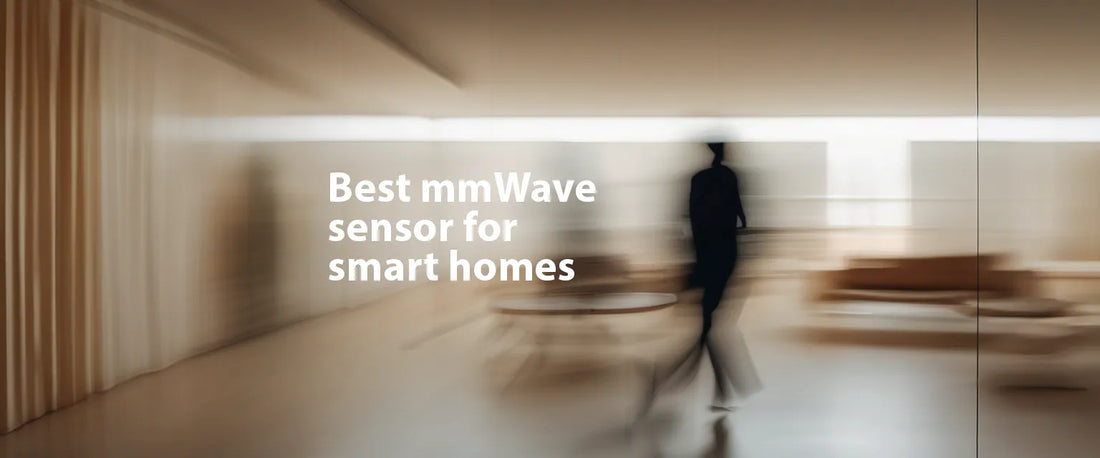mmWave sensors are the new kid on the home automation block and you'll soon see them in just about every smart home. Why? Because they deliver on the promise made long ago by motion sensors and multi-sensors alike: they detect people and they do it accurately. Presence detection is, in many ways, the holy grail of home automation.
Why replace motion sensors with mmWave sensors?
The motion sensors you're used to - that you might already have installed as part of your automation or alarm system - use PIR (passive infrared) to detect the movement of people. They do so by measuring the difference in temperature between a room's ambient temperature and an object in front of them. That's why PIRs are often poor at distinguishing between pets and people. And why they're rubbish at detecting presence. If you've ever used a PIR sensor as part of your automation routines you'll immediately know their presence limitations: sit still long enough and a PIR sensor will forget that you're present. If that motion sensor is part of a lighting automation routine you'll soon find that your lights turn off even when you're still in the room. They simply can no longer see you. If you haven't experienced this at home, then you've likely experienced it in a public space such as a public loo, where a motion sensor might turn off the lights or start flushing a toilet because it's effectively forgotten that you're there.
mmWave sensors don't have this flaw. Their promise is that they can privately monitor the presence of people in a room. Some mmWave sensors can even count the number of people within a room.
How do mmWave sensors work?
mmWave sensors use wave length technology not too dissimilar to radar to detect objects. A continuous signal is sent out by the mmWave sensor and bounces back when it encounters an object - within the sensor a calculation is made to determine if that object was always present (e.g. a room's wall) or is a new object (e.g. someone present in the room). Because the method is similar to radar other calculations can also be made, such as the part of a room the new object is in, its direction of travel, how far it is from the sensor, and even how many objects there are in total.
Because they're so accurate, you've likely already encountered plenty of mmWave sensors in your day to day life without realizing it. Parking sensors which tell you the distance between your car and an object in order to help you park are, for instance, often mmWave powered.
mmWave sensors vs. other sensors
Of course, mmWave sensors are not the first motion-focused smart home sensors ever released. We've touched on PIR already, but you'll also find technologies such as laser and ultrasonic used across a range of automation devices. How does mmWave compare to them?
| Features | mmWave | Infrared | Ultrasonic | Laser |
|---|---|---|---|---|
| Motion detection (major) | ||||
| Motion detection (minor e.g. hand movements) | ||||
| Motion detection (fine e.g. breathing) | ||||
| Presence detection | ||||
| Fall detection | ||||
| Detection speed | ||||
| Zone detection | ||||
| Direction of movement analysis | ● | ● | ● | ● |
| Distance measurement | ||||
| Detection through objects | ||||
| Accuracy overall | ||||
| Air temperature impacting accuracy | ||||
| Air moisture impacting accuracy | ||||
| Dust impacting accuracy | ||||
| Battery operation | ||||
| Cost |
Key: Weak - Good - Outstanding
While the cost of mmWave remains higher, do expect to see them come down in price over the coming 12 months as the key component, the mmWave radar chip itself, has become significantly better priced of late. Once a $20+ component for manufacturers, quality mmWave chips can now be had for $5 or so by manufacturers. Of course, not all chips are created equal. A $5 chip doesn't offer the same detection range, accuracy, or granular measurements as a $20 chip. So rather than expensive sensors going away, we'll start to enjoy a range of low-end accurate sensors and a higher-end range which offers a more complete feature set. In fact, that's already started to happen.
Our favorites: the best mmWave sensors 2023
We've tested a large number of sensors and even the chips used to engineer them. With the technology application being so new, most offer a poor experience, particularly false negative alerts where a sensor falsely believes a space to be empty and poor detection range. Thus, we've been able to narrow our focus down to two sensors which we think are the best mmWave sensors for home automation which you can presently buy.
Best mmWave sensor: premium
|
|
Aqara FP2 Human Presence Sensor
|
Pros
|
Cons
|
Best mmWave sensor: budget
|
|
Screek mmWave Sensor 1U
|
Pros
|
Cons
|
Smart home controllers that support mmWave
While there are a variety of mmWave sensors available which are built atop of Zigbee, at the time of writing support from popular gateways for mmWave sensors is light on the ground. The popular SmartThings hub, for instance, doesn't yet support Aqara FP1 or FP2. However, if you're using using Home Assistant or Tuya as your controller, you won't be limited to older motion-detection technologies.


